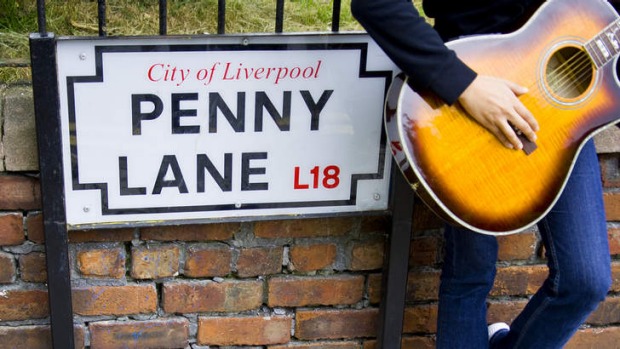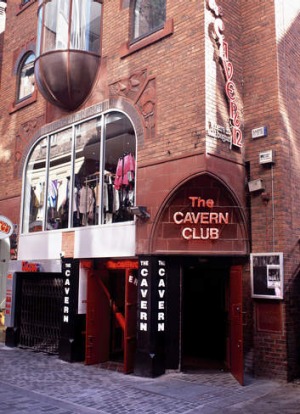
Flip Byrnes finds more to Liverpool than its four favourite sons but they're not a bad place to start.
It's 3pm on a Sunday and only a faint sound dribbling from a doorway indicates what lies below. The red door opening to The Cavern Club is like a yawning, salacious mouth, the staircase a darkened throat. I go down, down, down, listening to the Rolling Stones screaming Jumpin' Jack Flash, the beat intensifying with every step. I descend five flights of stairs, and it feels as though a decade is left on every flight until, arriving in The Cavern Club, it's 50 years ago. The Beatles played here more than 300 times.
In the underground brick arched tunnel, faces lit by red neon light and shoe soles sticking to the beer-stained floor, it's easy to believe the Stones are on stage (well, an excellent cover band is), and Liverpool and this venue are the crucible for a seismic musical British pop shift. Welcome to the birthplace of 1960s and '70s rock'n'roll.

As much of a tourist attraction as The Cavern Club may be, an authentic, lingering layer of excitement layers the walls of the subterranean vault like a second skin. A colleague, who grew up with The Beatles and for whom this visit is truly momentous, dissolves into tears, while the rest of the crowd, ranging from retirees to teenagers, die-hard Beatles fans and the curious, are rocking out during the 50th anniversary of The Beatles.
Oh, haven't you heard? Where have you been? This is the big 5-0 (one of many anniversaries, depending on which you celebrate), and fans are flocking to Liverpool. One of the biggest draws to this former industrial port city is the band, but since it became a Capital of Culture in 2008, the city is experiencing a Renaissance.
Buildings have been spruced and now sparkle, the waterfront area has been revitalised and the Tate has moved in. While people come to enjoy Beatlemania, they also discover a city bursting with newfound positivity.
But first: the trail of the Fabulous Four. I can't claim to have a degree in The Beatles, but my guide, Philip Coppell, literally can. He recently graduated from Liverpool Hope University with a Master of Arts in The Beatles, Popular Music and Society, and teaches the Music Tourism module.
How have I lucked into being hosted by arguably the best Beatles guide in the world? It's no accident. This is part of being on a Trafalgar guided holiday - not a tour in the traditional sense, but more a luxury trip for people who want to get under the skin of a country, with Wi-Fi-connected coaches and travel directors guiding the way.
On this trip, travelling between London and Edinburgh, we also experience the Be My Guest concept, where we dine at a local's house. We dine at aristocratic Whitwell Hall outside York with the Gillam family in Scotland by Loch Ard, where we are greeted with bagpipes before lunching at the working farm.
In between, we head off the beaten track and visit castles and National Heritage sites, such as the Industrial Revolution era Quarry Bank Mill, take a tipple at Scottish whisky distillery Glengoyne and venture to mystical Rosslyn Chapel, made famous by The Da Vinci Code. In between, there are swaths of free time for shopping in London or hiking up Arthur's Seat in Edinburgh.
The emphasis on local guides such as Phil is invaluable. His anecdotes bring the band to life in a way that a history book or vinyl never could.
On our Liverpool stop, the two-hour Beatles tour is all encompassing. We go to the Penny Lane, an outer-suburb sealed road peacefully lined with leafty green trees. The only sign of chaos is when my tour mates clamber over, around and on the painted Penny Lane road sign. (Apparently, the metal one was stolen once too often). We see the Menlove Avenue duplex "Mendips", where John Lennon lived with his Aunt Mini (who refused to allow George Harrison, with his quiff hairstyle, inside), and the other three Beatles' houses.
Paul McCartney sent tickets to his former neighbours when he last played, part of a continued apology for the daily parade down his former street.
We drive by the Springwood Cemetery gravesite of Lennon's mother, Julia, and then the spot where she was killed by a car.
Then it's on to Strawberry Fields (it's actually Strawberry Field - Lennon added the s because it sounded better), just up the road from the primary school and near the A565 airport turnoff.
The journey is exciting, but some of the locations themselves are banal, bland. It's interesting that sometimes the most iconic things are the most mundane.
Indeed, these are not magic places. These are the places that happened to be within a four-kilometre radius of four teenage boys without cars, but the places are still there. At the end of Penny Lane is the Sergeant Pepper bistro, no longer in use. The bank is still there. The fire engines are still washed outside and gleam. The barbershop where Lennon and McCartney had their hair cut (never Ringo Starr or Harrison, apparently) is still a barbershop and cuts fans' hair daily.
In these cases, the inspiration for songs that became legendary were simply the places by their local bus stop. The marvel is that the songs became global, taking on mythical proportions.
But would the four Liverpudlian boys who made it big recognise their 1960's city? Some would say hopefully not. Regenerated and gentrified - there are now more than 1 million trees in the city - there's buzz and pride. Dig through the grey and you'll find the gleam.
Like some off-axis supermodel, such as Georgia May Jagger, Liverpool is an ugly-beautiful city. Its character is in the industrial, the overcast moodiness, the regal, grey buildings laying a sombre blanket over the student town of 500,000.
The most impressive building the Anglican Cathedral Church of Christ. At 189 metres long, it's the world's longest, and in volume it's the fifth largest, the vast cavernous void monumental in proportions.
Giles Gilbert Scott won the architectural competition for a "20th century cathedral" in 1904 and went on to design 50 buildings, from this cathedral to the English red phone boxes.
This is a space to be used. The cathedral morphs into an art gallery. Rock concerts and dinners for 1000 are held here. There is a whispering arch. It has chairs instead of pews, so they can be easily moved. There is also a Beatles connection. McCartney failed his audition as a choirboy. Fifty-five years later, in 2008, he returned for the premiere of his choral work, Ecce Cor Meum (Behold My Heart), dedicated to first wife Linda, an event even he termed "my revenge trip".
Stroll along the Rope Walks, where rope was measured for sailing ships, and into Bold Street, lined with cafes. Continue to the World Heritage-listed Albert Dock. With 2.75 hectares of water ringed by five-storey warehouses, it is one of Britain's largest collection of protected buildings.
Stop at the 120-year-old Philharmonic Dining Rooms, one of the most ornate pubs in the country, with chandeliers and marble bathrooms. Grab a cosy snug and absorb all the Victorian details. Lennon once complained that the price of fame was, "not being able to go to the Phil for a drink". It's clear to see why he missed it.
The writer travelled as a guest of Trafalgar and Visit Britain.
TRIP NOTES
MORE INFORMATION
visitbritain.com
GETTING THERE
British Airways flies from Sydney and Melbourne to London Heathrow daily. Phone 1300 767 7177 or see britishairways.com/au. London to Liverpool via Virgin Trains, see virgintrains.co.uk.
STAYING THERE
The Liverpool Marriott Hotel City Centre is smack bang in the art and cultural area and overlooks Queen Square. Marriott.com/Liverpool
TRAVELLING THERE
Trafalgar has eight itineraries. The 15-day The Brittania guided holiday is from $3599 a person, twin share, travel dates from April 11 to October 3 2014. Phone 1300 663 043 or see trafalgar.com.